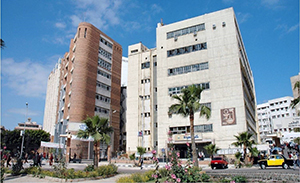The first neurosurgical practice in Egypt was started by Ahmed Abu Zikry, MD, a general surgeon who studied neurosurgery at the Mayo Clinic and the Lahey Clinic in 1949. He then returned to the University of Cairo to establish his practice in neurosurgery along with general surgery. In 1956, Dr. Boctor established the first neurosurgical department in Egypt at the University of Alexandria, (where I am currently on staff), with just eight beds.

Now, neurosurgery is a very progressive and growing field in Egypt. The current health care system providing such service includes four main venues: the government provides free treatment through existing university teaching hospitals, the National Health Insurance Service serves the public free of charge through an expanding system of National Health Insurance hospitals, military hospitals are restricted to military personnel and their dependents as well as paying civilians and privately-owned clinics and hospitals provide paid services.
The majority of patients are treated in university-affiliated and teaching hospitals where residency programs for neurosurgical training exist. In these hospitals, centers of excellence are established for treating patients with complex cranial, skull base and cerebrovascular pathologies. The private practice mostly involves the spectrum of spine surgery, along with other less complex neurosurgical procedures.
My initial introduction to neurosurgery was secondary to a special interest in otorhinolaryngology during medical school. I was fascinated by the neuro-otologic procedures performed under the operating microscope. On a day during a combined case with multiple operating teams, this interest shifted completely to neurosurgery on seeing the delicate details of “the pulsating brain” under the magnifying scope. Still today, I think this fascination with such exquisite detailed anatomy had the profound impact on me to pursue further training in skull base and cerebrovascular surgery.
Neurosurgical practice in Egypt covers the whole spectrum of neurosurgical problems with established subspecialties like spine, pediatric cranial and radiosurgery. There are several Gamma Knife centers in Egypt, probably the most famous is the one moderated with the Karolinska Institute of Sweden, operating since 2001. Spine surgery is mostly performed by neurosurgeons, but there are a growing number of orthopaedic surgeons performing spine and instrumented deformity procedures in Egypt. Modern functional and endovascular interventions are fairly recent subspecialties that have been introduced to the practice in Egypt in the last decade, with increasing numbers of members in their respective societies.

The daily practice of a neurosurgeon in Egypt is quite busy. For university staff and consultants, time is mostly spent seeing and operating on patients in their affiliated hospitals with supervisory and educational roles for their training residents. They also have their private clinics and practice, which usually consume any remaining time in the day after their academic obligations are done. This is very different from the practice in the U.S. where you are either in academia or private practice, allowing more time, in my opinion, for research and clinical studies.
I think a unique procedure performed in Egypt is what is referred to as the temporary “Ventriculo-subgaleal shunt.” The purpose of this procedure is to divert cerebrospinal fluid in cases of hydrocephalous secondary to meningitis, to a small subgaleal pocket. In Egypt, a higher risk of infection with prolonged insertions of external ventricular drains is common. This modification allows implementation of a closed internal system for fluid diversion with a decreased infection rate but with one drawback: the need for repeated aspiration of this fluid from the subgaleal space when it is full. This is done till the infection clears off and the patient becomes ready for reinsertion of his or her ventriculo-peritoneal shunt once more.
I think the biggest challenge facing a good neurosurgical practice in Egypt is the availability of collaborative ancillary services that would provide comprehensive treatment and follow-up plans for patients requiring regular checkups. Also, as the neurosurgery practice grows throughout the nation, there is an increasing demand for what is now a considerably deficient number of ICU beds needed to absorb the increasing caseload of treated patients undergoing complex neurosurgical procedures.
The biggest opportunity for neurosurgery in Egypt lays in the hands of its neurosurgeons themselves. Egypt is very fortunate to have a very active neurosurgical society promoting excellence in performance and education for all its members. This is clearly reflected by the enthusiasm of new generations of highly motivated young neurosurgeons, seen in training fellowships all over the world from Japan to across Europe and the U.S., returning to their respective universities and institutions to serve their local communities.
[aans_authors]







